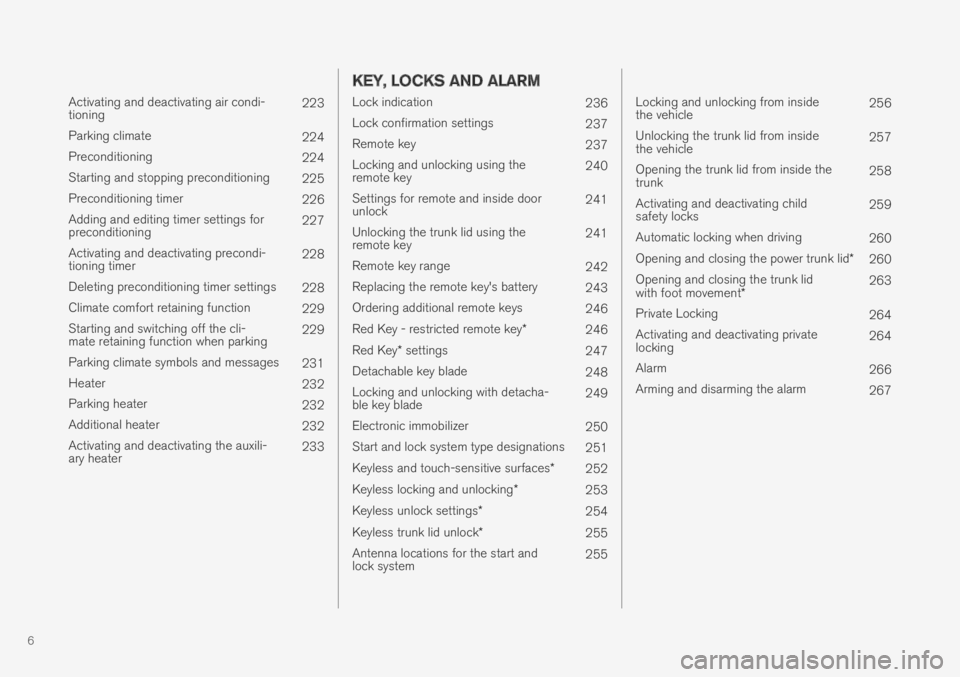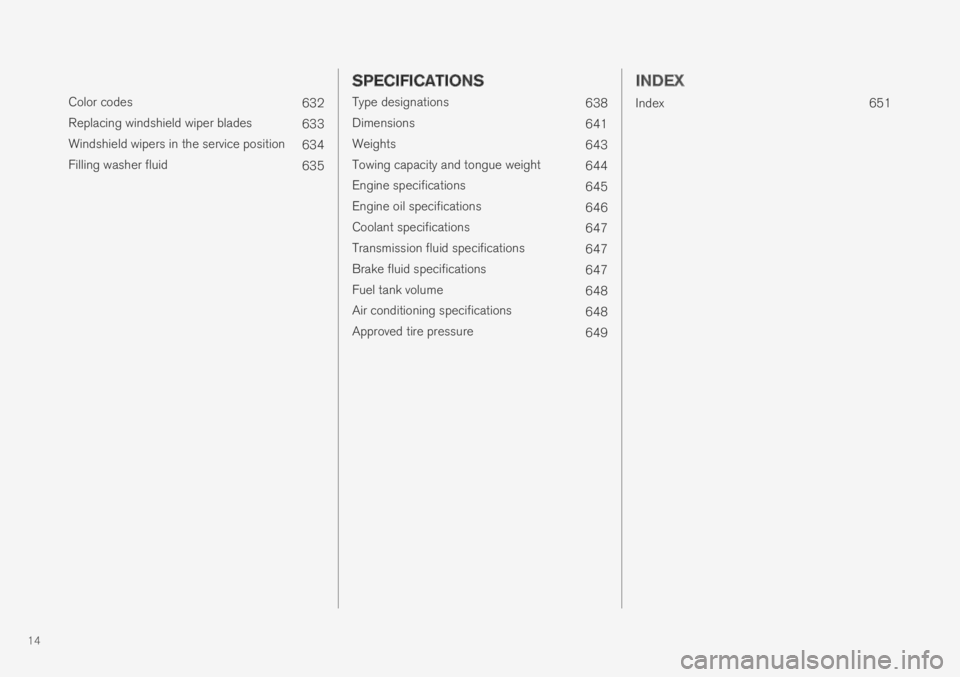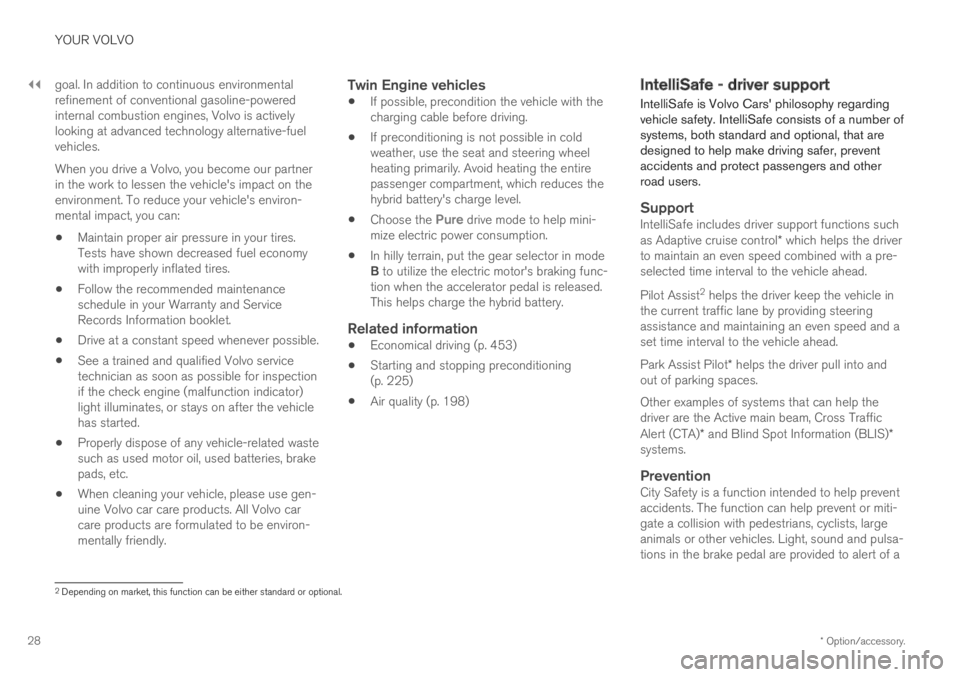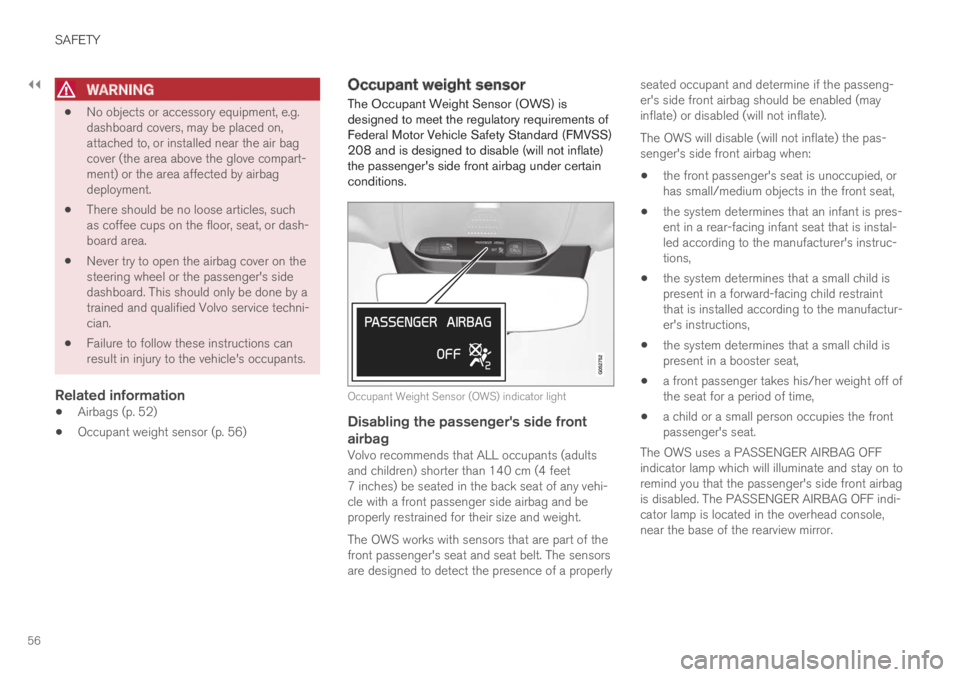air condition VOLVO S90 TWIN ENGINE 2019 Owners Manual
[x] Cancel search | Manufacturer: VOLVO, Model Year: 2019, Model line: S90 TWIN ENGINE, Model: VOLVO S90 TWIN ENGINE 2019Pages: 669, PDF Size: 14.33 MB
Page 4 of 669

2
OWNER'S INFORMATION
Owner's information16
Owner's Manual in the center display17
Navigate in the Owner's Manual inthe center display18
Owner's manual in mobile devices20
Volvo Cars support site21
Using the Owner's Manual21
YOUR VOLVO
Contacting Volvo26
Volvo ID26
Creating and registering a Volvo ID26
Drive-E ‒ purer driving pleasure27
IntelliSafe - driver support28
Sensus - connection and entertainment30
Software Updates33
Data recording33
Terms & Conditions for Services35
Customer Privacy Policy35
Important information on accessoriesand extra equipment35
Accessory installation36
Connecting equipment to the vehi-cle's data link connector37
Technician certification38
Viewing the Vehicle IdentificationNumber (VIN)38
Volvo Structural Parts Statement39
Driver distraction39
SAFETY
Safety42
Safety during pregnancy43
Occupant safety43
Reporting safety defects44
Recall information45
Whiplash Protection System46
Seat belts47
Buckling and unbuckling seat belts48
Seat belt tensioners50
Resetting the electric seat belt ten-sioners51
Door and seat belt reminders51
Airbags52
Driver/passenger-side airbags53
Occupant weight sensor56
Side airbags59
Inflatable curtain60
Safety mode61
Starting and moving the vehiclewhen it is in safety mode62
Child safety63
Child restraints65
Infant seats67
Convertible seats69
Booster cushions71
TABLE OF CONTENTS
Page 8 of 669

6
Activating and deactivating air condi-tioning223
Parking climate224
Preconditioning224
Starting and stopping preconditioning225
Preconditioning timer226
Adding and editing timer settings forpreconditioning227
Activating and deactivating precondi-tioning timer228
Deleting preconditioning timer settings228
Climate comfort retaining function229
Starting and switching off the cli-mate retaining function when parking229
Parking climate symbols and messages231
Heater232
Parking heater232
Additional heater232
Activating and deactivating the auxili-ary heater233
KEY, LOCKS AND ALARM
Lock indication236
Lock confirmation settings237
Remote key237
Locking and unlocking using theremote key240
Settings for remote and inside doorunlock241
Unlocking the trunk lid using theremote key241
Remote key range242
Replacing the remote key's battery243
Ordering additional remote keys246
Red Key - restricted remote key*246
Red Key* settings247
Detachable key blade248
Locking and unlocking with detacha-ble key blade249
Electronic immobilizer250
Start and lock system type designations251
Keyless and touch-sensitive surfaces*252
Keyless locking and unlocking*253
Keyless unlock settings*254
Keyless trunk lid unlock*255
Antenna locations for the start andlock system255
Locking and unlocking from insidethe vehicle256
Unlocking the trunk lid from insidethe vehicle257
Opening the trunk lid from inside thetrunk258
Activating and deactivating childsafety locks259
Automatic locking when driving260
Opening and closing the power trunk lid*260
Opening and closing the trunk lidwith foot movement*263
Private Locking264
Activating and deactivating privatelocking264
Alarm266
Arming and disarming the alarm267
Page 16 of 669

14
Color codes632
Replacing windshield wiper blades633
Windshield wipers in the service position634
Filling washer fluid635
SPECIFICATIONS
Type designations638
Dimensions641
Weights643
Towing capacity and tongue weight644
Engine specifications645
Engine oil specifications646
Coolant specifications647
Transmission fluid specifications647
Brake fluid specifications647
Fuel tank volume648
Air conditioning specifications648
Approved tire pressure649
INDEX
Index651
Page 29 of 669

YOUR VOLVO
}}
* Option/accessory.27
Creating a Volvo ID using the Volvo On Call
app 1
1. Download the latest version of the Volvo OnCall app from a smartphone, via e.g. AppStore, Windows Phone or Google Play.
2. On the app's start page, create a Volvo IDand enter a personal email address.
3. Follow the instructions that will be sent auto-matically to this email address.
> A Volvo ID has now been created. Seebelow for information on how the ID isregistered to the vehicle.
Registering your Volvo ID to the vehicle
If your Volvo ID was created using the Volvo OnCall app, follow these steps to register the ID tothe vehicle:
1. If you have not already done so, downloadthe Volvo ID app from Download Center inthe center display's App view.
NOTE
To download apps the vehicle must be con-nected to the internet.
2. Start the app and enter your Volvo ID/emailaddress.
3.Follow the instructions that will be automati-cally sent to the email address connected toyour Volvo ID.
>Your Volvo ID has now been registered tothe vehicle. The Volvo ID services can nowbe used.
Related information
Volvo ID (p. 26)
Download apps (p. 481)
Handling system updates via Download Cen-ter (p. 587)
Internet-connected vehicle* (p. 523)
Drive-E ‒ purer driving pleasure
Volvo is committed to the well-being of its cus-tomers. As a natural part of this commitment, wecare about the environment in which we all live.Concern for the environment means an everydayinvolvement in reducing our environmentalimpact.
Volvo's environmental activities are based on aholistic view, which means we consider the over-all environmental impact of a product throughoutits complete life cycle. In this context, design, pro-duction, product use, and recycling are all impor-tant considerations. In production, Volvo haspartly or completely phased out several chemicalsincluding CFCs, lead chromates, asbestos, andcadmium; and reduced the number of chemicalsused in our plants 50% since 1991.
Volvo was the first in the world to introduce intoproduction a three-way catalytic converter with aLambda sond, now called the heated oxygen sen-sor, in 1976. The current version of this highlyefficient system reduces emissions of harmfulsubstances (CO, HC, NOx) from the exhaust pipeby approximately 95 - 99% and the search toeliminate the remaining emissions continues.Volvo is the only automobile manufacturer tooffer CFC-free retrofit kits for the air conditioningsystem of all models as far back as the 1975model 240. Advanced electronic engine controlsand cleaner fuels are bringing us closer to our
1
Vehicles with Volvo On Call.
Page 30 of 669

||
YOUR VOLVO
* Option/accessory.28
goal. In addition to continuous environmentalrefinement of conventional gasoline-poweredinternal combustion engines, Volvo is activelylooking at advanced technology alternative-fuelvehicles.
When you drive a Volvo, you become our partnerin the work to lessen the vehicle's impact on theenvironment. To reduce your vehicle's environ-mental impact, you can:
Maintain proper air pressure in your tires.Tests have shown decreased fuel economywith improperly inflated tires.
Follow the recommended maintenanceschedule in your Warranty and ServiceRecords Information booklet.
Drive at a constant speed whenever possible.
See a trained and qualified Volvo servicetechnician as soon as possible for inspectionif the check engine (malfunction indicator)light illuminates, or stays on after the vehiclehas started.
Properly dispose of any vehicle-related wastesuch as used motor oil, used batteries, brakepads, etc.
When cleaning your vehicle, please use gen-uine Volvo car care products. All Volvo carcare products are formulated to be environ-mentally friendly.
Twin Engine vehicles
If possible, precondition the vehicle with thecharging cable before driving.
If preconditioning is not possible in coldweather, use the seat and steering wheelheating primarily. Avoid heating the entirepassenger compartment, which reduces thehybrid battery's charge level.
Choose the Pure drive mode to help mini-mize electric power consumption.
In hilly terrain, put the gear selector in modeB to utilize the electric motor's braking func-tion when the accelerator pedal is released.This helps charge the hybrid battery.
Related information
Economical driving (p. 453)
Starting and stopping preconditioning(p. 225)
Air quality (p. 198)
IntelliSafe - driver support
IntelliSafe is Volvo Cars' philosophy regardingvehicle safety. IntelliSafe consists of a number ofsystems, both standard and optional, that aredesigned to help make driving safer, preventaccidents and protect passengers and otherroad users.
Support
IntelliSafe includes driver support functions suchas Adaptive cruise control* which helps the driverto maintain an even speed combined with a pre-selected time interval to the vehicle ahead.
Pilot Assist2 helps the driver keep the vehicle inthe current traffic lane by providing steeringassistance and maintaining an even speed and aset time interval to the vehicle ahead.
Park Assist Pilot* helps the driver pull into andout of parking spaces.
Other examples of systems that can help thedriver are the Active main beam, Cross TrafficAlert (CTA)* and Blind Spot Information (BLIS)*systems.
Prevention
City Safety is a function intended to help preventaccidents. The function can help prevent or miti-gate a collision with pedestrians, cyclists, largeanimals or other vehicles. Light, sound and pulsa-tions in the brake pedal are provided to alert of a
2Depending on market, this function can be either standard or optional.
Page 35 of 669

YOUR VOLVO
}}
33
Software Updates
So that you as a Volvo customer shall have thebest possible experience from your car, Volvo iscontinuously developing the systems in the carsand the services that you are offered.
You can update the software in your Volvo to thelatest version when your car is serviced at anauthorized Volvo dealer. The latest softwareupdate gives you access to new functions andimprovements, as well as previous improvementsincluded with previous software updates.
For more information about released updates andanswers to frequently asked questions, please goto support.volvocars.com.
NOTE
Functionality after updating may vary depend-ing on market, model, model year and options.
Related information
Sensus - connection and entertainment(p. 30)
Handling system updates via Download Cen-ter (p. 587)
Data recording
As part of Volvo's commitment to safety andquality, certain information is recorded regardingvehicle operation, functionality and incidents.
US market only:
EDR
This vehicle is equipped with an event datarecorder (EDR). The main purpose of an EDR isto record, in certain crash or near crash-likesituations, such as an air bag deployment orhitting a road obstacle, data that will assist inunderstanding how a vehicle's systemsperformed. The EDR is designed to record datarelated to vehicle dynamics and safety systemsfor a short period of time, typically 30 seconds orless. The EDR in this vehicle is designed torecord such data as:
How various systems in your vehicle wereoperating;
Whether or not the driver and passengersafety belts were buckled/fastened;
How far (if at all) the driver was depressingthe accelerator and/or brake pedal; and,
How fast the vehicle was traveling.
These data can help provide a betterunderstanding of the circumstances in whichcrashes and injuries occur. NOTE: EDR data arerecorded by your vehicle only if a non-trivial crashsituation occurs; no data are recorded by theEDR under normal driving conditions and no
personal data (e.g., name, gender, age, and crashlocation) are recorded. However, other parties,such as law enforcement, could combine theEDR data with the type of personally identifyingdata routinely acquired during a crashinvestigation.
To read data recorded by an EDR, specialequipment is required, and access to the vehicleor the EDR is needed. In addition to the vehiclemanufacturer, other parties, such as lawenforcement, that have the special equipment,can read the information if they have access tothe vehicle or the EDR.
ASDR
This vehicle is equipped with an Active SafetyData Recorder (ASDR). This data recorder canrecord information related to the usage of thecar, functional errors and active safety actuations(e.g. auto brake). The information saved is usedby technicians for service and maintenance todiagnose and repair possible faults that hasoccurred in the vehicle and to fulfil certain legalrequirements. The registered data can also, incongregated form, be used for research- andproduct development –purposes to continuouslyimprove the safety and quality of Volvo Cars. Formore information contact your local Volvo retailer.
Page 36 of 669

||
YOUR VOLVO
34
Canadian market only:
This vehicle is equipped with an “Event DataRecorder” (EDR). The main purpose of the EDRis to register and record data in traffic accidentsor accident-like situations, e.g. if an airbagdeploys or if the vehicle hits an obstacle in theroad. This data is recorded in order to help under-stand how the vehicle's systems perform in thesetypes of situations. The EDR is designed torecord data related to vehicle dynamics andsafety systems for a short period of time, usually30 seconds or less.
The EDR in this vehicle is designed to recorddata in traffic accidents or accident-like situationssuch as:
How the various systems in the vehicle per-formed;
Whether the driver and passenger seat beltswere tightened/buckled;
The driver's use of the accelerator/brakepedal;
How fast the vehicle was moving.
This data can help provide a better understandingof the circumstances in which traffic accidentsand injuries occur. The EDR records data only if anon-trivial accident situation occurs. EDR doesnot record any data during normal driving condi-tions. The system also never registers data onwho is driving the vehicle or the geographicallocation of the accident or near-accident. How-
ever, other parties, such as law enforcement,could combine the EDR data with the type of per-sonally identifiable information that is routinelyacquired during an accident investigation. Specialequipment and access to either the vehicle or theEDR is required to read this recorded data.
In addition to the EDR, the vehicle is equippedwith a number of computers that continuouslycontrol and monitor the vehicle's performance.These computers may record data during normaldriving conditions, particularly if they detect afault relating to the vehicle's operation and func-tionality or upon activation of the vehicle's activedriver support functions (e.g. City Safety or theauto-brake function).
Some of this recorded data is required by techni-cians performing service and maintenance inorder to diagnose and rectify any faults that mayhave occurred in the vehicle. The recorded infor-mation is also needed to enable Volvo to fulfilllegal and other regulatory requirements. Informa-tion registered in the vehicle is stored in its com-puters until the vehicle is serviced or repaired.
In addition to the above, the recorded informationmay be used in aggregated form for research andproduct development purposes in order to contin-uously improve the safety and quality of Volvovehicles.
Volvo will not provide this information to any thirdparties without the vehicle owner's consent. How-ever, national legislation and regulations may
require Volvo to disclose this type of informationto law enforcement or other authorities that canclaim a legal right to the information. Specialtechnical equipment, which Volvo and workshopsthat have entered agreements with Volvo haveaccess to, is required to read and interpret therecorded data. Volvo is responsible for ensuringthat information provided to Volvo in conjunctionwith service and maintenance is stored and han-dled securely and in compliance with applicablelegal requirements. For more information, pleasecontact a Volvo retailer.
Related information
Contacting Volvo (p. 26)
Volvo Structural Parts Statement (p. 39)
Page 40 of 669

||
YOUR VOLVO
38
Canada
IC: 20839-ACUII06
This device complies with Industry Canadalicense-exempt RSS standards. Operation is sub-ject to the following two conditions:
(1) this device may not cause interference, and
(2) This device must accept any interferencereceived, including interference that may causeundesired operation.
Related information
Important information on accessories andextra equipment (p. 35)
Technician certification
In addition to Volvo factory training, Volvo sup-ports certification by the National Institute forAutomotive Service Excellence (A.S.E.).
Certified technicians have demonstrated a highdegree of competence in specific areas. Besidespassing exams, each technician must also haveworked in the field for two or more years before acertificate is issued. These professional techni-cians are best able to analyze vehicle problemsand perform the necessary maintenance proce-dures to keep your Volvo at peak operating con-dition.
Twin Engine vehicles
Technicians performing work on a vehicle withelectrification should also have the necessarytraining and specialized certification required forperforming repairs and/or maintenance on avehicle with electrification.
WARNING
A number of electrical components in TwinEngine vehicles use high-voltage current andcan be extremely dangerous if handled incor-rectly. These components and any orange wir-ing in the vehicle may only be handled bytrained and qualified Volvo service techni-cians.
Viewing the Vehicle IdentificationNumber (VIN)
When contacting a Volvo retailer, about e.g. yourVolvo On Call subscription, your Vehicle Identifi-
cation Number (VIN3) may be needed.
1.Tap Settings in the Top view in the centerdisplay.
2. Proceed to SystemSystem Information
Vehicle Identification Number.
> The vehicle identification number will bedisplayed.
3Vehicle Identification Number
Page 44 of 669

SAFETY
42
Safety
The vehicle is equipped with a number of safetysystems that work together to help protect thevehicle's driver and passengers in the event ofan accident.
The vehicle is equipped with a number of sensorsthat may react in the event of an accident andactivate different safety systems, such as the air-bag system and seat belt tensioners. Dependingon the specific conditions of the accident, e.g.collisions at certain angles, overturning or swerv-ing, the systems react differently to help providethe best protection.
There are also mechanical safety systems suchas the Whiplash Protection System. The vehicleis also built so that a large part of the force of acollision is distributed to the vehicle's members,pillars, floor, roof and other parts of the body.
After an accident, the vehicle's safety mode maybe activated if any important function in the vehi-cle has been damaged.
Warning symbol in the instrument panel
The warning symbol in the instrumentpanel illuminates when the vehicle'selectrical system is in ignition mode II.The symbol will go out after approx. 6seconds if no faults are detected in the vehicle'ssafety systems.
WARNING
If the warning symbol remains illuminated orswitches on while driving and the messageSRS airbag Service urgent Drive toworkshop is displayed in the instrumentpanel, this indicates that something in thesafety system is not functioning properly.Volvo recommends contacting an authorizedVolvo workshop for repairs as soon as possi-ble.
WARNING
Never attempt to alter or repair any of thevehicle's safety systems yourself. Incorrectlyperformed repairs to any system could impairfunction and lead to serious injury. Volvo rec-ommends contacting an authorized Volvoworkshop.
If this dedicated warning symbol is notfunctioning, the general warning sym-bol will illuminate instead and the samemessage will be displayed in the instru-ment panel.
Related information
Safety during pregnancy (p. 43)
Occupant safety (p. 43)
Reporting safety defects (p. 44)
Recall information (p. 45)
Seat belts (p. 47)
Airbags (p. 52)
Whiplash Protection System (p. 46)
Safety mode (p. 61)
Child safety (p. 63)
Page 58 of 669

||
SAFETY
56
WARNING
No objects or accessory equipment, e.g.dashboard covers, may be placed on,attached to, or installed near the air bagcover (the area above the glove compart-ment) or the area affected by airbagdeployment.
There should be no loose articles, suchas coffee cups on the floor, seat, or dash-board area.
Never try to open the airbag cover on thesteering wheel or the passenger's sidedashboard. This should only be done by atrained and qualified Volvo service techni-cian.
Failure to follow these instructions canresult in injury to the vehicle's occupants.
Related information
Airbags (p. 52)
Occupant weight sensor (p. 56)
Occupant weight sensor
The Occupant Weight Sensor (OWS) isdesigned to meet the regulatory requirements ofFederal Motor Vehicle Safety Standard (FMVSS)208 and is designed to disable (will not inflate)the passenger's side front airbag under certainconditions.
Occupant Weight Sensor (OWS) indicator light
Disabling the passenger's side front
airbag
Volvo recommends that ALL occupants (adultsand children) shorter than 140 cm (4 feet7 inches) be seated in the back seat of any vehi-cle with a front passenger side airbag and beproperly restrained for their size and weight.
The OWS works with sensors that are part of thefront passenger's seat and seat belt. The sensorsare designed to detect the presence of a properly
seated occupant and determine if the passeng-er's side front airbag should be enabled (mayinflate) or disabled (will not inflate).
The OWS will disable (will not inflate) the pas-senger's side front airbag when:
the front passenger's seat is unoccupied, orhas small/medium objects in the front seat,
the system determines that an infant is pres-ent in a rear-facing infant seat that is instal-led according to the manufacturer's instruc-tions,
the system determines that a small child ispresent in a forward-facing child restraintthat is installed according to the manufactur-er's instructions,
the system determines that a small child ispresent in a booster seat,
a front passenger takes his/her weight off ofthe seat for a period of time,
a child or a small person occupies the frontpassenger's seat.
The OWS uses a PASSENGER AIRBAG OFFindicator lamp which will illuminate and stay on toremind you that the passenger's side front airbagis disabled. The PASSENGER AIRBAG OFF indi-cator lamp is located in the overhead console,near the base of the rearview mirror.